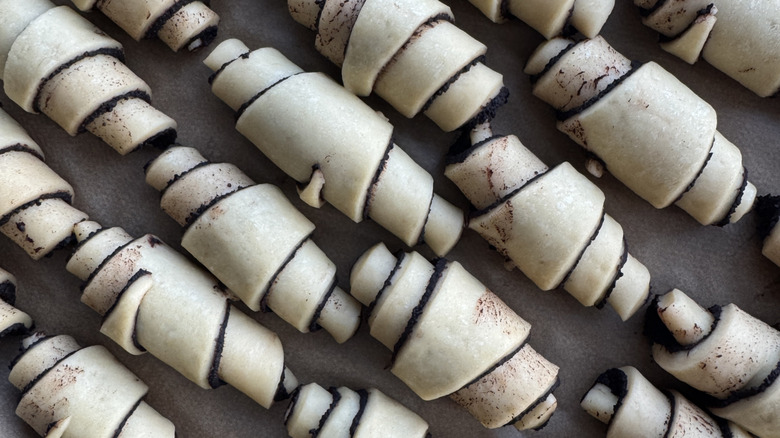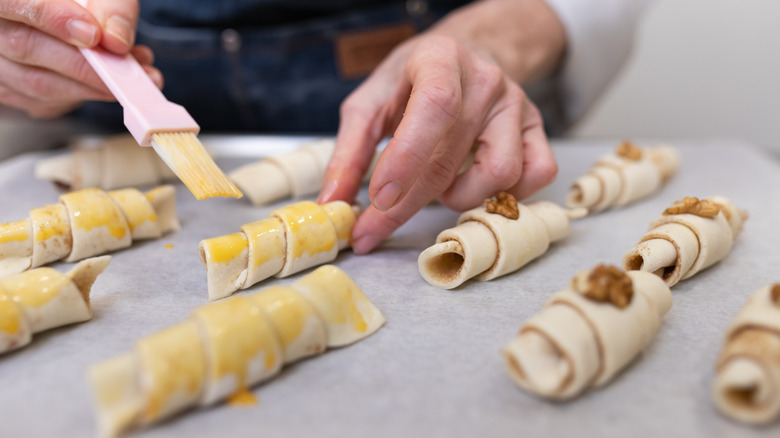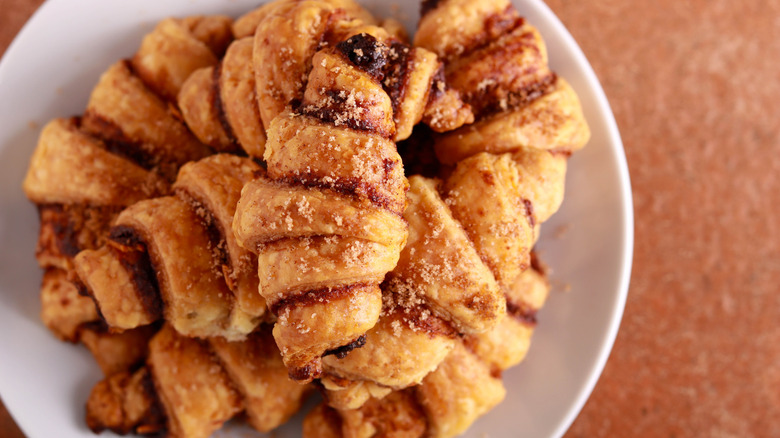Roll Rugelach More Easily With One Simple Hack
There is never a bad time of day for rugelach. Whether you like to indulge in these buttery crescent-shaped cookies with your morning coffee or as a sweet after-dinner treat, it's a perfect pastry for all occasions. With a name meaning "little twists" in Yiddish, rugelach are made from triangles of dough that are spread with sweet fillings (or savory, in the case of this everything bagel rugelach recipe) before being rolled and baked. While making them at home is often straightforward, there's one simple hack that can make big batches of these cookies even easier: Use a pizza cutter.
That's right, your circular pizza cutter is good for more than just slicing a pie, cutting through blocks of cheese, or prepping better sliders. Hacking your rugelach is easy: Once you've rolled your dough into a thin circle and spread on your filling of choice –– like chocolate, peanut butter, or chopped nuts with honey –– grab your trusty cutter and slice the dough into eight even wedges, just like a pizza. Then, simply roll each triangle from the wide end towards the pointed tip, giving the rugelach its iconic shape. From here you can either pop them straight in the oven or store the shaped cookies in the freezer for up to three months.
More tips for making great rugelach
Making the perfect rugelach starts with the right dough, and there are two main variations that employ different ingredients and yield unique consistencies. Yeasted dough, which requires kneading and proofing, results in lighter rugelach that boasts an airy, bread-like texture. Cream cheese-based dough, however, creates a denser, flakier cookie and can be prepped just like a pie crust with the help of your food processor.
While both methods will result in delicious pastries, cream cheese-based dough is considered by many bakers to be easier to roll out and more forgiving to work with than its yeasted counterpart. Regardless of which method you use, chilling your dough in the fridge (minimum two hours for cream cheese and six hours for yeast) is crucial for allowing it to properly set.
Once you've decided on a dough, the next (and perhaps most important) part of making rugelach is choosing the right filling. Because of the versatility of the format, every baker and bubbe has their own unique spin on rugelach fillings –– some will stick with traditional flavors like chocolate and cinnamon, but more ambitious folks might opt for black sesame, blue cheese, sun-dried tomatoes, and more.
Whether you decide to make your own pistachio spread from scratch or simply reach for your favorite apricot preserves in the cupboard, there's no way to go wrong here. Just be wary of piling too much filling on top of your dough; spreading a thin, even layer of whatever you have on hand is the best way to prevent over-stuffing your rugelach, which can impact how well they bake.
The history of rugelach
As with many dishes of the Jewish diaspora, rugelach has seen many tweaks and adaptations as it made its way from Eastern Europe to North America. Originally developed in Poland during the Middle Ages, rugelach is believed to be inspired by the moon-shaped Austrian cookie known as kipferl. Traditionally prepared with yeasted dough, rugelach underwent a bit of a transformation when the popular pastry made its way to the United States as a result of mass Jewish immigration in the mid-20th century.
Adapting the recipe to use whatever ingredients were easily available, many Jewish-American bakers began using cream cheese in their rugelach dough in place of yeast. This cut down significantly on prep time, as the dough no longer needed to be kneaded and proofed for hours. Today, the legacy of rugelach lives on across the Ashkenazi Jewish diaspora, often being prepared specially for holidays such as Hanukkah, Rosh Hashanah, and Shavuot. Thanks to New York baker Alvin Lee Smalls, April 29th has even been designated National Rugelach Day in the U.S., in order to pass on and preserve the historical significance of the pastry.



